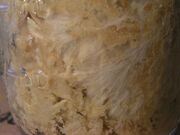(spelling the word 'describe' correctly!) Tag: Source edit |
No edit summary Tag: Visual edit |
||
| Line 1: | Line 1: | ||
| − | [[Image:BRF_wood_shiitake.jpg|thumb|right|Shiitake [[mycelium]] [[colonize]]s [[brown rice flour]] and wood [[substrate]] in a mason jar]] |
+ | [[Image:BRF_wood_shiitake.jpg|thumb|right|Shiitake [[mycelium]] [[colonize]]s [[brown rice flour]] and wood [[substrate]] in a mason jar ]] |
[[Mycelium]] (pl. mycelia) is the collective body of [[hyphae]] that constitutes the vegetative stage of a [[fungus]]. The mycelium can be considered the main body or form of the fungus and is often described as being filamentous. Growth occurs by the asexual reproduction of [[hypha]], which grow into branching chains. Mycelium is important to the fungus because it can navigate through soil or wood and use the substrate as food, which the fungus will need if it is to produce [[fruit bodies]] ([[basidiocarps]]) such as [[mushrooms]], brackets, truffles, cups, or morels. |
[[Mycelium]] (pl. mycelia) is the collective body of [[hyphae]] that constitutes the vegetative stage of a [[fungus]]. The mycelium can be considered the main body or form of the fungus and is often described as being filamentous. Growth occurs by the asexual reproduction of [[hypha]], which grow into branching chains. Mycelium is important to the fungus because it can navigate through soil or wood and use the substrate as food, which the fungus will need if it is to produce [[fruit bodies]] ([[basidiocarps]]) such as [[mushrooms]], brackets, truffles, cups, or morels. |
||
Latest revision as of 23:30, 21 May 2022

Shiitake mycelium colonizes brown rice flour and wood substrate in a mason jar
Mycelium (pl. mycelia) is the collective body of hyphae that constitutes the vegetative stage of a fungus. The mycelium can be considered the main body or form of the fungus and is often described as being filamentous. Growth occurs by the asexual reproduction of hypha, which grow into branching chains. Mycelium is important to the fungus because it can navigate through soil or wood and use the substrate as food, which the fungus will need if it is to produce fruit bodies (basidiocarps) such as mushrooms, brackets, truffles, cups, or morels.
Mycelium excretes exoenzymes which can kill living tissue (necrotrophic) and then absorb that dead material (saprotrophic), simply absorbing material that was already dead (again, saprotrophic), or by feeding off of living tissue (biotrophic).
References[]
- Kendrick, Bryce. 2000. The Fifth Kingdom. Newburyport, MA: R. Pullins Company
- Watling, Roy. 2003. Fungi. Washington, D.C: Smithsonian Books